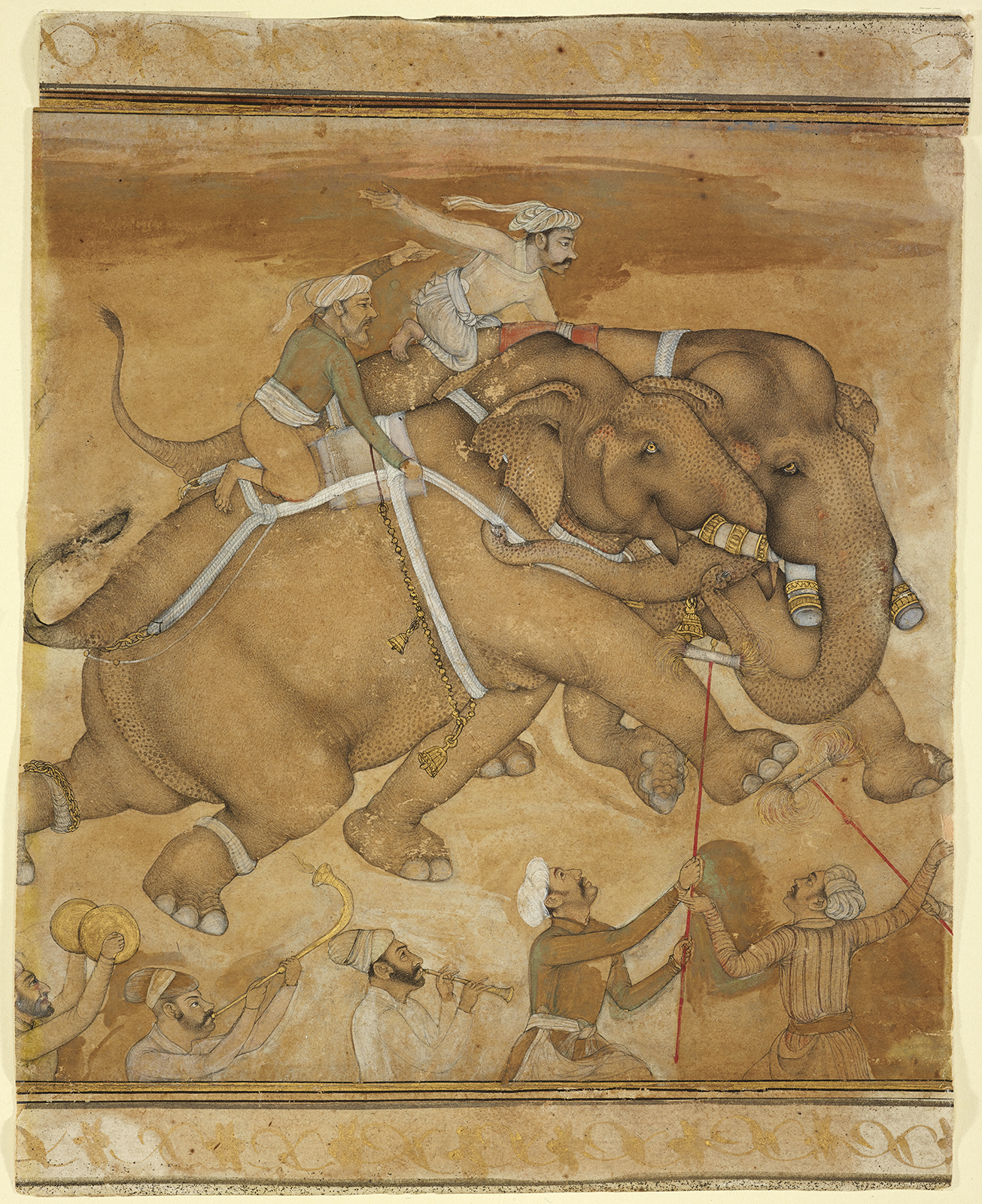Click on the image to zoom
Two Struggling Elephants
- Accession Number:AKM187
- Place:India
- Dimensions:22.6 x 17.9 cm
- Date:ca. 1630
- Materials and Technique:ink, opaque watercolour, and gold on paper
This single-page drawing shows two trained elephants struggling. They are moving in the same direction, not opposing each other, as is usual in elephant or camel fight depictions. The rings on their tusks and jangling chains of bells are decorated with gold, indicating they likely belong to the imperial stable. Their riders, the mahouts, hold tightly to white, braided harnesses with one hand while stretching out the other arm. The mahouts’ gestures, their head posture and viewing direction, as well as the almost parallel positioning of the elephants, provide a second aspect to this painting—elephants coming into contact and conflict during a race. At the bottom of the drawing are three musicians playing cymbals, horn, and flute, while two other men jab long-handled prods at the elephants. The accompanying musicians provide clear evidence of an entertainment. The faces of the mahouts and other courtiers and musicians are individualized portraits and probably refer to specific individuals at court, a specialty of Mughal artists.
Further Reading
During the reign of Akbar the Great (r. 1556–1605) in Mughal India, elephants were used in war and also as royal entertainment. For such entertainments the animals often fought duels or were engaged in races. One of the most important topics in Islamic art is the animal fight, particularly dynamic depictions of their struggles, such as the dragon and the kylin (a mythological creature with a horse-like body, dragon’s head, cloven hooves, flaming wings, and paws; see AKM32) or fighting camels with their specific iconography (see AKM75).
According to Asok Kumar Das, the topic of the elephant fight was adapted from the camel fight into a motif and was often used in Mughal painting.[1] Both reflect the popularity of the fights as social events and were challenging for the sportsmen and artists alike. The sport was even practised by Akbar himself; it was said of Akbar by his son, Jahangir, that he could ride uncontrollable, enraged elephants.[2] Clearly, this courtly sport was more dangerous than the practice of coaching, goading, and controlling fighting camels by keepers on the ground.
The drawing was part of a panorama; the cuts are clearly seen on the tails and feet of the elephants. A cut-off human arm on the right holding a prod supports the evidence of the drawing having been cut out of a bigger work, which most certainly comprised several stages of the event.
— Filiz Çakır Phillip
Notes
1. Asok Kumar Das, “The Elephant in Mughal Painting.” In Marg: A Magazine of the Arts 50, no. 3 (Mumbai: Marg Publications, 1999): 53.
2. W.M. Thackston, trans., The Jahangirnama: Memoirs of Jahangir, Emperor of India (Washington, DC: Freer Gallery of Art and the Arthur M. Sackler Gallery, Smithsonian Institution, 1999), 40.
References
Das, Asok Kumar. “The Elephant in Mughal Painting.” In Marg: A Magazine of the Arts 50, no. 3 (1999): 36–54. ISBN: 9788185026435
Phillip, Filiz Çakır. Enchanted lines: drawings from the Aga Khan Museum collection. 2014. ISBN: 9780991992874
Thackston, W.M., trans. The Jahangirnama: Memoirs of Jahangir, Emperor of India. Washington, DC: Freer Gallery of Art and the Arthur M. Sackler Gallery, Smithsonian Institution, 1999. doi: 10.5479/sil.849796.39088018028456
Note: This online resource is reviewed and updated on an ongoing basis. We are committed to improving this information and will revise and update knowledge about this object as it becomes available.


